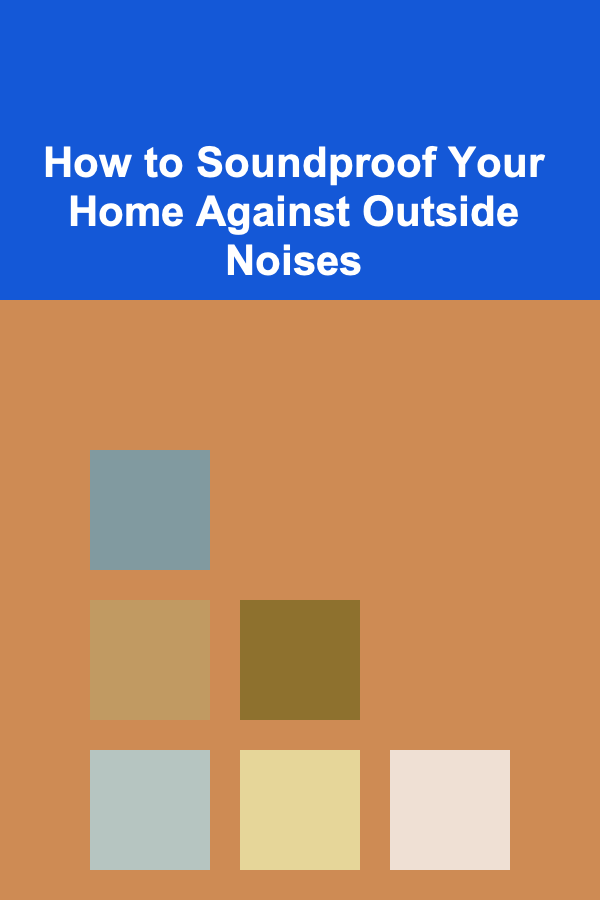
How to Soundproof Your Home Against Outside Noises
ebook include PDF & Audio bundle (Micro Guide)
$12.99$8.99
Limited Time Offer! Order within the next:

In a world where urbanization continues to expand, noise pollution has become an unavoidable part of modern life. From honking car horns to the hum of construction sites, the constant presence of external noise can significantly affect the peace and tranquility of your home. While some people might get used to living with background noise, others find it to be a major source of stress, distraction, and even health issues. For those who value silence or need quiet for productivity, soundproofing becomes not just a luxury, but a necessity.
Soundproofing your home against outside noise can significantly improve your quality of life, whether you work from home, enjoy peace, or need to sleep without disruption. The goal of this guide is to offer practical solutions and advanced techniques for reducing outside noise. By understanding how sound works, the types of noise you may encounter, and how to combat it, you can create a sanctuary of silence in your own living space.
Understanding Sound and Noise
Before diving into the methods and materials you can use for soundproofing, it's essential to understand how sound travels and how noise can enter your home. Sound is a vibration that travels in waves through the air, and when it encounters an obstacle, such as walls, windows, or doors, it can pass through or reflect off the surfaces. The goal of soundproofing is to minimize these vibrations and prevent sound from entering the space.
Noise typically falls into two categories: airborne noise and structure-borne noise.
Airborne Noise
Airborne noise refers to sound that travels through the air, such as conversations, traffic, or music. It is the most common type of external noise you'll encounter in a typical home. When airborne noise enters a room, it typically travels through gaps, thin walls, or windows.
Structure-Borne Noise
Structure-borne noise occurs when sound travels through solid structures like walls, floors, and ceilings. This type of noise is often caused by vibrations from footsteps, furniture movement, or even heavy machinery. While it is less common than airborne noise, it can be particularly disruptive in multi-level homes or apartment buildings.
Understanding these two types of noise will help you implement more targeted strategies for soundproofing your home.
Why Soundproofing Is Important
Living in a noisy environment can have a number of negative effects on your physical and mental health. Some of the most significant consequences of prolonged exposure to high noise levels include:
- Increased stress levels: Noise is a constant source of stress for many people, triggering the release of cortisol, the body's stress hormone. Over time, this can lead to chronic stress, anxiety, and even depression.
- Sleep disturbance: Noise can interfere with sleep, making it difficult to fall asleep or stay asleep throughout the night. Lack of rest can lead to fatigue, reduced cognitive function, and poor decision-making.
- Decreased productivity: External noise, especially in home offices, can lead to distractions that hinder focus and concentration, lowering overall productivity.
- Hearing damage: Prolonged exposure to high levels of noise can result in hearing impairment, a condition that is irreversible in most cases.
In essence, soundproofing is not only about creating a more peaceful environment, but also about safeguarding your well-being.
Effective Methods for Soundproofing Your Home Against Outside Noises
There are a wide variety of techniques and materials that can be employed to reduce or eliminate outside noise. The effectiveness of each method will depend on the type of noise you're dealing with, the construction of your home, and your budget.
1. Sealing Gaps and Cracks
One of the most cost-effective ways to reduce outside noise is to seal any gaps or cracks in your home's structure. Sound can travel through even the smallest openings, so it's important to ensure that your windows, doors, and walls are properly sealed.
Doors and Windows
- Weatherstripping: Installing weatherstripping around the perimeter of your doors and windows is an easy way to prevent sound from seeping through the edges. Weatherstripping comes in a variety of materials, including foam, rubber, and vinyl, all of which can be cut to fit the gaps around your doors and windows.
- Door Sweeps: A door sweep is a strip of material attached to the bottom of the door that helps seal the gap between the door and the floor. This simple addition can significantly reduce noise leakage.
- Acoustic Caulk: For cracks and gaps around window frames and doorframes, using acoustic caulk is a great way to fill the spaces. Acoustic caulk is specifically designed to remain flexible and block sound transmission.
Walls and Ceilings
- Fill Small Cracks: Inspect the walls, ceiling, and floors for any small cracks or holes where sound could enter. Use standard caulk or an acoustic sealant to fill in these spaces, which will prevent noise from traveling through.
- Acoustic Sealant: In addition to using standard caulk, you can use specialized acoustic sealants that provide superior soundproofing properties. These sealants are designed to remain flexible, allowing them to fill the gaps more effectively without cracking over time.
2. Soundproofing Windows
Windows are one of the biggest culprits when it comes to noise intrusion. Thin or single-pane windows allow a large amount of sound to pass through, making it essential to take measures to minimize the noise that enters through them.
- Double or Triple-Glazing: Replacing your single-pane windows with double or triple-glazed windows is one of the most effective ways to soundproof your home. The space between the layers of glass acts as a buffer that prevents sound from passing through.
- Soundproof Window Inserts: If replacing the windows is not an option, you can install soundproof window inserts. These are transparent, removable panels that fit snugly over your existing windows and help reduce the amount of noise that enters the room.
- Heavy Curtains: Soundproof curtains or heavy drapes made from thick, dense fabrics like velvet or polyester can help absorb sound and reduce noise transmission. These curtains are designed specifically for noise reduction and can be an effective solution for rooms with windows that let in a lot of external sound.
3. Enhance Wall Insulation
Walls are the primary barrier between your home and external noise. If your walls are thin or poorly insulated, sound can easily pass through them. Adding additional insulation can significantly improve the soundproofing of your home.
- Mass-Loaded Vinyl (MLV): MLV is a dense material that can be added to the walls or ceilings of your home to block noise. It is particularly effective at reducing airborne noise and can be installed directly on the wall or under drywall for maximum soundproofing.
- Acoustic Panels and Foam: Acoustic panels are designed to absorb sound, preventing it from reverberating within the room. These panels can be mounted directly to the walls to reduce sound reflection and make the room quieter. Foam panels, which are often pyramid or wedge-shaped, are also an excellent option for reducing sound.
- Adding Drywall Layers: For a more robust soundproofing solution, consider adding an additional layer of drywall to your walls. This extra layer of material will increase the mass of the wall, making it more difficult for sound to pass through.
4. Soundproof the Floor
If you live in a multi-story home or an apartment, the floor can be another entry point for noise. Footsteps, furniture movement, and other vibrations can travel through the floor and disturb your peace.
- Thick Carpeting and Rugs: Adding thick carpets or rugs to the floors can help absorb impact noise and reduce vibrations. The denser the material, the better it will be at soundproofing.
- Acoustic Underlayment: If you have hardwood or tile floors, consider installing an acoustic underlayment beneath your flooring. This material helps to reduce both airborne and impact noise by creating a sound-dampening barrier between the floor and the subfloor.
- Cork Flooring: Cork is a natural sound-absorbing material that can be used to reduce noise transmission through floors. It provides both thermal and acoustic insulation, making it a great option for those seeking both comfort and noise reduction.
5. Improve Your Ceiling
If you live in an apartment or a multi-story house, sound may also travel from the floor above. In these cases, soundproofing your ceiling can significantly reduce noise from upstairs neighbors or external sources.
- Acoustic Ceiling Tiles: Installing acoustic ceiling tiles can help absorb sound and prevent it from traveling through the ceiling. These tiles are designed specifically to reduce noise and can be installed easily in any room.
- Decoupling the Ceiling: For a more permanent solution, you can decouple the ceiling from the structure above by installing a new layer of drywall with resilient channels. This method isolates the ceiling from the building structure and reduces vibrations that can pass through.
6. Install a White Noise Machine
While structural changes can do a lot to reduce noise, some external sounds may still find their way into your home. In such cases, white noise machines can be a useful tool for masking unwanted sounds.
A white noise machine produces a consistent, neutral sound that can cover up external noises like traffic, voices, or construction. By masking disruptive sounds, these devices can help you focus and sleep more peacefully.
7. Create a Quiet Zone
In households with multiple people or busy environments, it's essential to create a designated "quiet zone" where noise levels are minimized. Establishing this area and encouraging others to respect it can provide a space where you can focus on work or relax without constant distractions.
Consider using visual cues like a "Do Not Disturb" sign or closing doors to signal that the area is intended for quiet time.
Conclusion
Soundproofing your home against outside noises is an investment in both your well-being and your peace of mind. Whether you're looking to block out the sounds of traffic, loud neighbors, or construction, there are a variety of methods available to help you create a quieter, more tranquil living environment. By understanding how sound travels and taking the necessary steps to seal gaps, improve insulation, and add soundproofing materials, you can greatly reduce noise intrusion.
Reading More From Our Other Websites
- [Beachcombing Tip 101] Best Guide to Spotting and Cataloguing Bioluminescent Organisms While Night‑time Beachcombing
- [Home Renovating 101] How to Make Your Home Renovation Eco-Friendly
- [Home Storage Solution 101] How to Turn Unused Spaces Into Valuable Storage Areas
- [Organization Tip 101] How to Use Aromatherapy for a Mindful Atmosphere
- [Sewing Tip 101] Best Tips for Sewing Seamlessly on Stretch Knit Fabrics
- [Personal Care Tips 101] How to Use Shampoo to Strengthen Brittle Hair
- [Organization Tip 101] How to Document Your Emergency Kit Inventory
- [Home Pet Care 101] How to Handle Pet Allergies in Your Home
- [Home Cleaning 101] How to Use Microfiber Cloths for Stain Removal: Maximizing Their Power on Spills and Marks
- [Home Rental Property 101] How to Manage Short-Term Rental Properties Like Airbnbs Successfully

Time-Saving Hacks for Busy Dads
Read More
How to Start a Vegetable Garden from Scratch
Read More
How To Combat Dry Patches on Your Skin
Read More
How To Protect Your Financial Data Online
Read More
How to Optimize Your React Performance with Profiling Tools
Read More
How to Understand Legal Jargon: A Lawyer's Explanation
Read MoreOther Products

Time-Saving Hacks for Busy Dads
Read More
How to Start a Vegetable Garden from Scratch
Read More
How To Combat Dry Patches on Your Skin
Read More
How To Protect Your Financial Data Online
Read More
How to Optimize Your React Performance with Profiling Tools
Read More